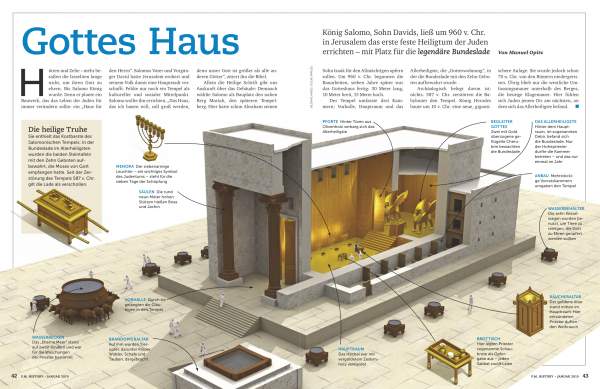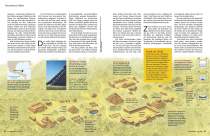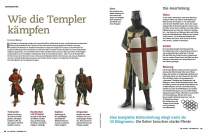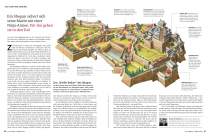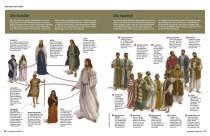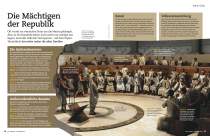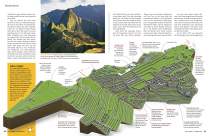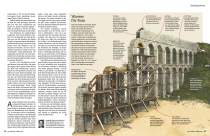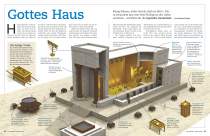P.M. History
-
Chichén Itzá
The Mayas infographic, which locates the main buildings of the archaeological site of Chichén Itzá, in the Mexican peninsula of Yucatan, occupies the central pages of an extensive report, entitled Blut für die Götter (Blood for the Gods), that the German magazine of history P.M. History dedicated to this Mesoamerican city, considered the largest of the late classical or of the early postclassic period of the Mayan civilization, between the years 800 and 1100. The editor of the magazine used the graphic of the internal structure of the building of the Caracol astronomical observatory, which appears in the original Infographics90's infographic, to illustrate the text entitled Sternendeuter (Astrologers) on the next page. The Chichén Itzá site was declared a World Heritage by UNESCO in 1988.
Page(s): 46-47 and 48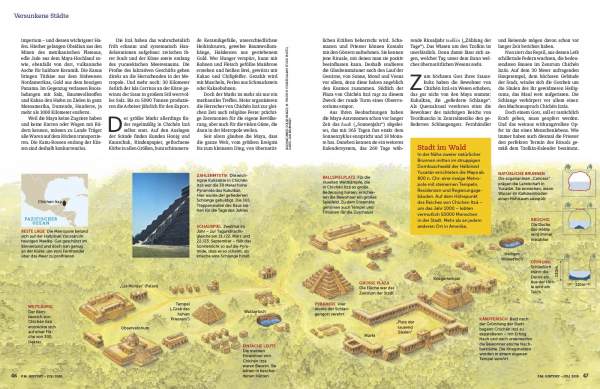
-
Ancient Greece
The prestigious German history magazine P.M. History produced a comprehensive report, titled Europa Erste Genies (The first flash of Europe), dedicated to the ancient Greek civilization. In its pages P.M. History used two infographics from Infographics90: The Acropolis of Athens and The Macedonian Empire. The Acropolis of Athens infographic, which served to illustrate the golden age of classical Greek culture, the one of the V century BC. also known as Pericles' century, shows the distribution of the buildings of this sacred precinct, built in honor of the goddess Athena, protector of the city: the temples of Niké and Artemis, the Parthenon, the Erechtheion, the Pandrosius, the Arreforion, the altar of Athena, the sanctuaries of Zeus Polieo and Pandión and, outside the walls, the Eleusinión. The Macedonian Empire infographic shows Alexander the Great facing, along with his phalanges, the elephants of King Poros, on the banks of the Hydaspes river around 326 BC, when the Macedonian conqueror undertook his campaign against the kingdoms of northern India.
Pages of The Acropolis of Athens: 38-39
Pages of The Macedonian Empire: 46-47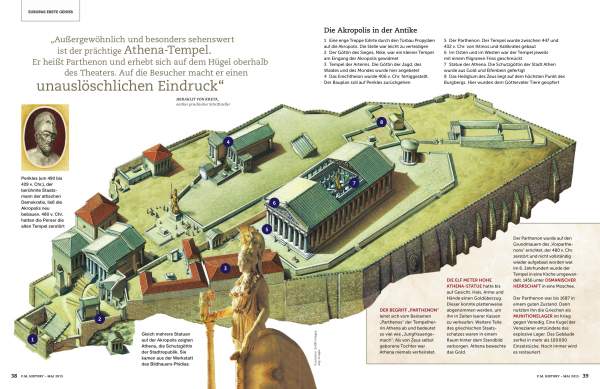
-
Templars and Crusades
In an extensive report dedicated to the Order of the Knights of the Temple, the German magazine P.M. History offered the infographic titled Wie die Templer kämpfen (How the Templars Fought), which, made up of the sum of two elements from two different original infographics, mixed two styles of infographic design with excellent results. The Order of the Knights of the Temple was one of the most powerful Christian military orders of the Middle Ages. Founded in the Holy Land in 1138 or 1139 by several French knights at the end of the First Crusade, the full name of this religious-military institution was Order of the Poor Knights of Christ from the Temple of Solomon. Its primary mission was to protect the pilgrims who came to the Holy Land. The order was definitively approved by the Catholic Church in the council of Troyes, in 1129. Rich and powerful, it lost its influence after the failure of the Crusades and was persecuted by King Philip IV of France, who got the support of Pope Clement V for attacking and dissolving the order, accused of heresy.
Page(s): 44-45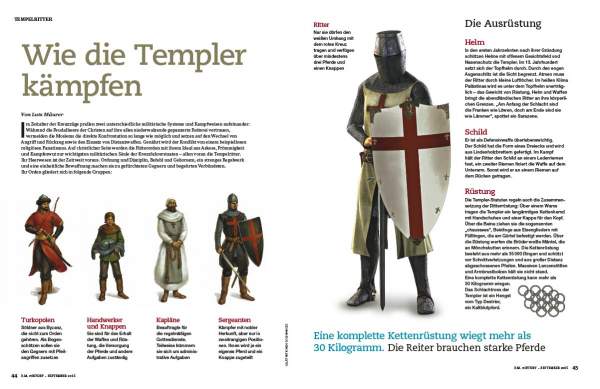
-
Hanseatic Cog
In the report that the monthly German history magazine P.M. History dedicated to Hansa, the cog could not be missing, the most representative ship of the Hansa, the shipping and mercantile league society that dominated the maritime trade of northern Europe between the XIII and XVI centuries. The Hanseatic League was founded by the seafarers and merchants from the port cities of Germany (Lübeck, Bremen, Hamburg, Wismar, Stralsund, Danzig ...), who established an alliance. The cog was an innovative ship. It didn´t use oars for navigation and incorporated the rudder, the first that was attached to the hull structure. It measured between 15 and 25 m in length, and 5 to 8 m in width. It was powered by the deployment of a large square sail and the largest cogs could carry up to 200 tons of cargo. The materials that it most often transported in its traffic through the North and Baltic Seas were leathers, wood, resin, amber, salted fish and cereals. Thanks to the cog´s innovations, Lübeck and Danzig stood out as shipyards that manufactured and exported it to Mediterranean ports. P.M. History entitled the infographic: Für Profit und Krieg (For Trade and War), which kept the scheme and elements of the original infographic.
Page(s): 24-25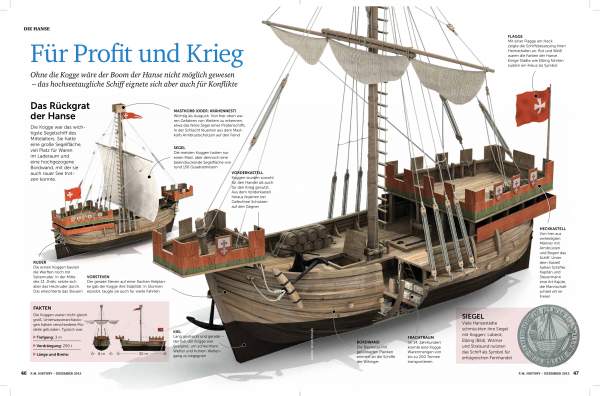
-
Himeji Castle
Himeji Castle appeared briefly in the pages of the German history magazine P.M. History, illustrating Das Japan der Samurai (The Japan of the Samurai), in an extensive article about this warrior corp and the ninjas. Built in 1346 in the coastal city of Himeji, it underwent profound transformations between 1580 and 1609. Also known as the "White Heron", due to the alabaster used on the facades, this labyrinthine fortress was declared a World Heritage Site in 1993 by Unesco.
Page(s): 44-47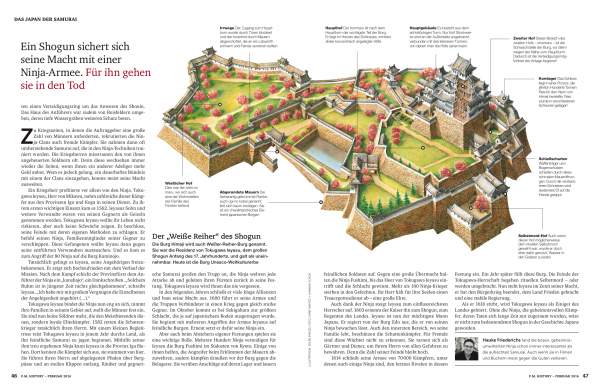
-
Jesus Christ
The family and biographical ties can also be summarized in an infographic, as evidenced by the one the German magazine P.M. History dedicated to the family of Jesus and his disciples, the apostles, in a comprehensive report, under the title Die Welt von Jesus (The World of Jesus), about the time and life of Christ, founder of Christianity. The published infographic had a separate title on each of its pages: Die Familie (The Family) and Die Apostel (The Apostles).
Page(s): 46-47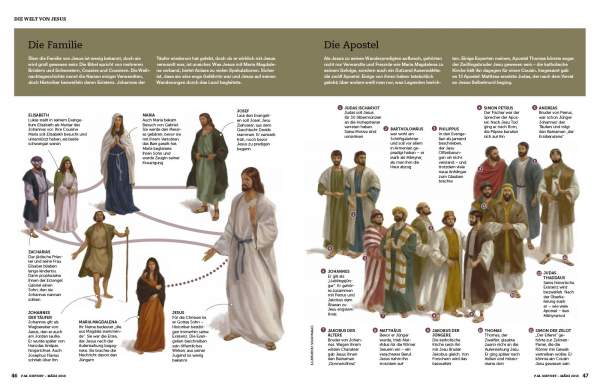
-
Politics in Rome
A session in the Senate illustrates the picture entitled Die Mächtigen der Republik (The Mighty Ones of the Republic), included in an extensive article dedicated to Julius Caesar. The German history magazine P.M. History used this graphic support to describe the cursus honorum, the public positions that the Roman patricians could carry out throughout their public life.
Page(s): 58-59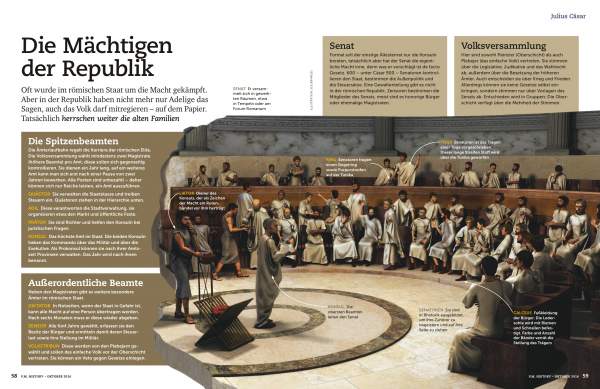
-
Machu Picchu
The German history magazine P.M. History chose this planimetric view of the Inca citadel of Machu Picchu to illustrate the most advanced civilization in the southern hemisphere. Built in the 15th century at 2,430 meters above sea level, between peaks of the Eastern Andes mountain range, in the Peruvian region of Cuzco, the "lost city of the Incas" was "rediscovered" by the American professor and explorer Hiram Bingham in 1911. Machu Picchu (in Quechua, "old mountain"), considered a masterpiece of Inca engineering and architecture, has been a World Heritage Site since 1983 and in 2007 was chosen as one of the Seven Wonders of the World.
Page(s): 44-45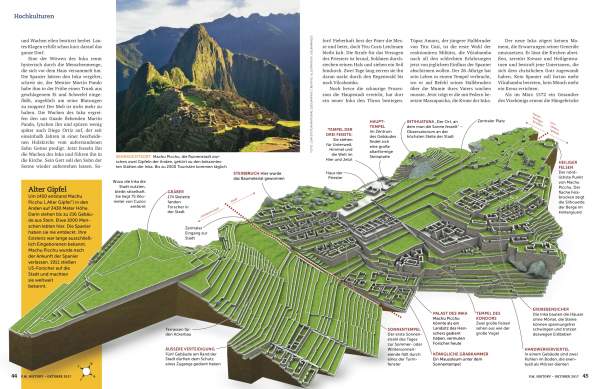
-
Roman Aqueduct
The infographic of the construction of the Roman aqueduct is one of the most requested. Due to its quality and detail, it has been chosen by many historical magazines to illustrate the engineering of Antiquity or Roman civilization. On this occasion, it puts the final touch to a report in the magazine P.M. History, entitled Auf Beton gebaut (Made of Concrete), on Roman civil engineering. Wasser für Rom (Water for Rome) was the title of the text that accompanied the image of the aqueduct. The infographic shows the construction of a bridge with double arches for an aqueduct, inspired by that of the Spanish city of Segovia, declared a World Heritage Site.
Page(s): 34-35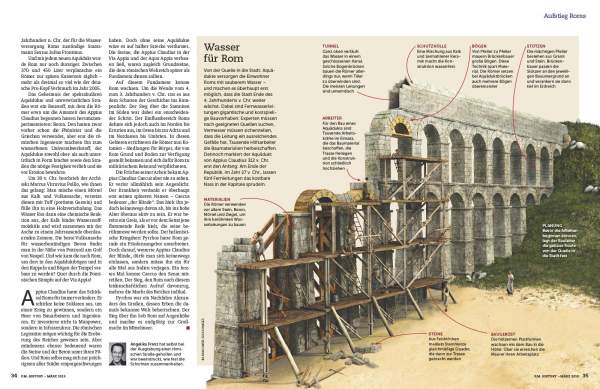
-
Solomon’s Temple
Under the title Gottes Haus (The House of God), the prestigious German history magazine P.M. History showed the recreation of Solomon's Temple in Jerusalem.
Page(s): 42-43